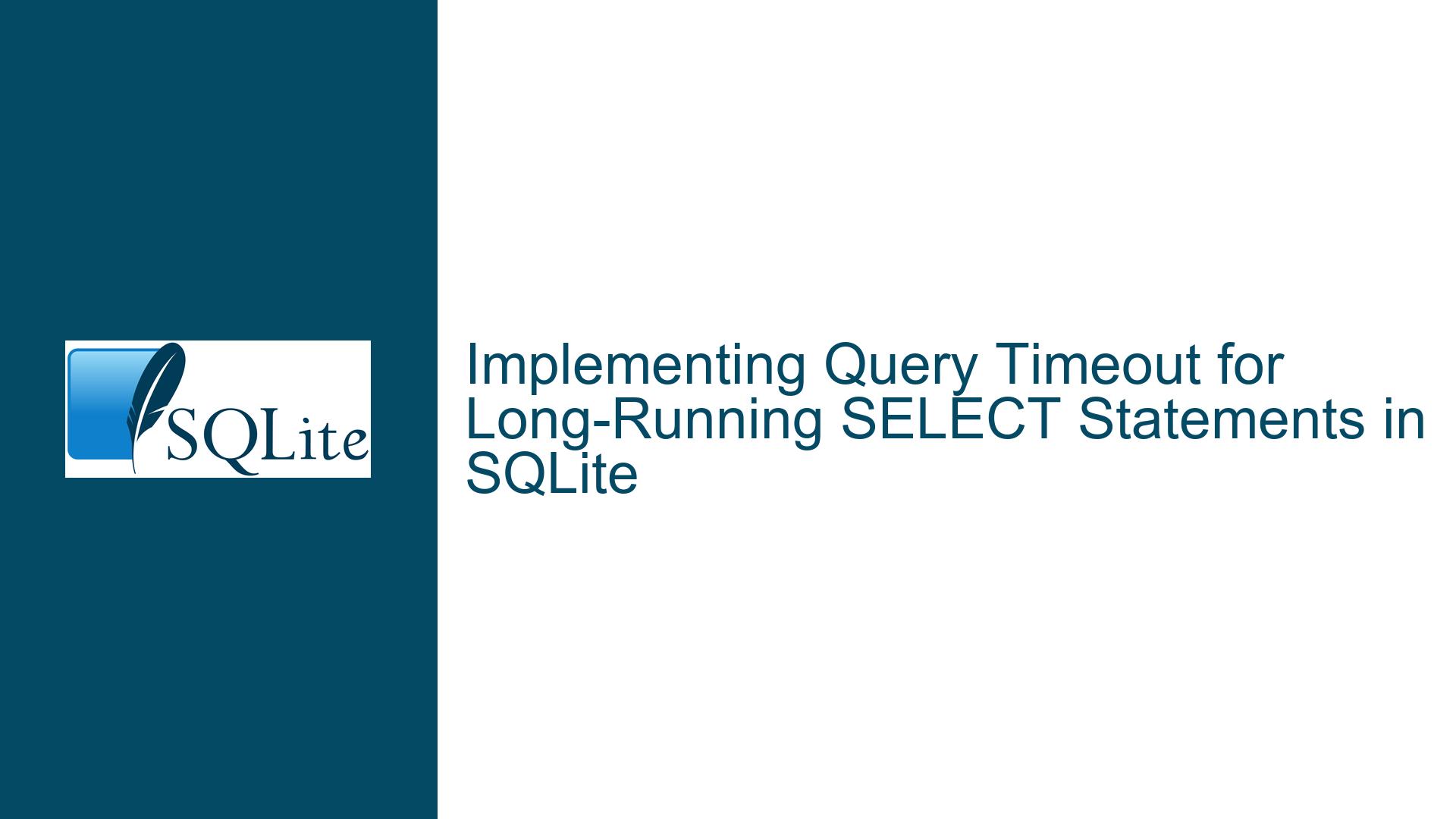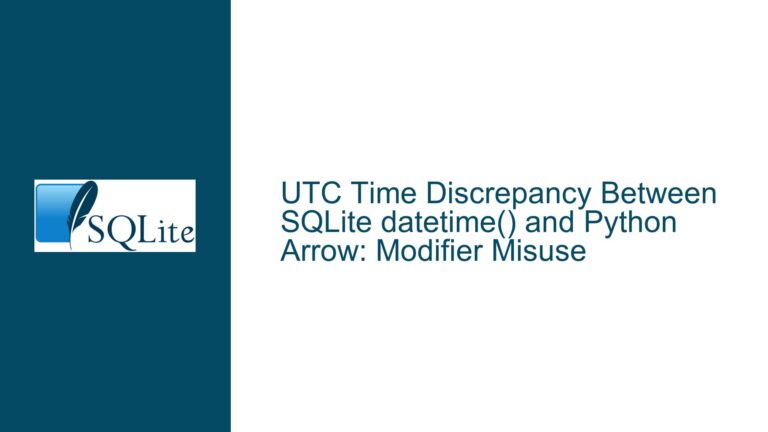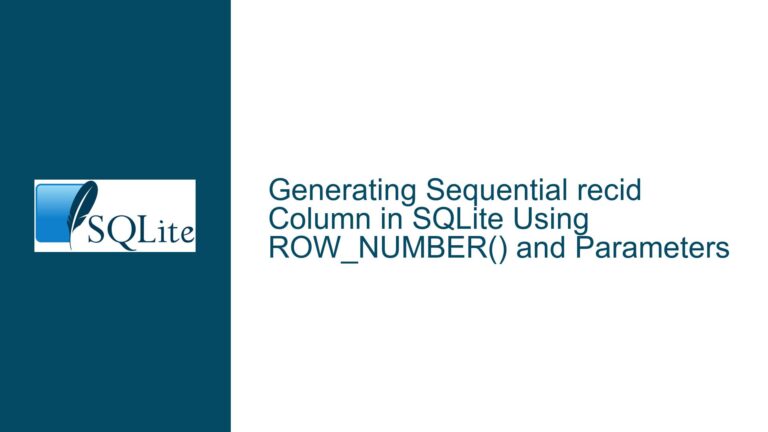Implementing Query Timeout for Long-Running SELECT Statements in SQLite
Understanding the Need for Query Execution Timeouts in SQLite
SQLite does not natively provide a direct connection-level parameter to enforce a timeout for the execution duration of a SELECT query. This limitation becomes critical when applications require predictable response times or need to prevent resource exhaustion caused by unexpectedly long-running queries. The core challenge lies in differentiating between two distinct scenarios: lock contention (where a query waits for access to a database resource) and execution time (where the query itself takes too long to process data). Solutions must address these scenarios separately, as SQLite’s built-in mechanisms and workarounds apply differently to each.
Distinguishing Lock Contention from Execution Delays
Lock Contention and the busy_timeout PRAGMA
SQLite’s busy_timeout PRAGMA sets a maximum time (in milliseconds) that a connection will wait for a lock to be released before returning SQLITE_BUSY. This is relevant when multiple connections attempt to write to the database concurrently. For example, if Connection A holds a write lock, Connection B attempting to write will wait up to the duration specified by busy_timeout before aborting. However, this mechanism does not interrupt a query that is actively processing data—it only governs waiting time for locks. Misconfiguring this parameter or misunderstanding its scope leads to incorrect assumptions about query cancellation for long-running operations.
Execution Time and the Progress Handler
Long-running SELECT queries typically result from inefficient execution plans, missing indexes, or complex operations (e.g., cross joins, subqueries). To enforce a timeout in such cases, SQLite’s sqlite3_progress_handler() API allows developers to register a callback function that triggers after a specified number of virtual machine operations (VDBE steps). By tracking elapsed time within this handler, queries exceeding a predefined threshold can be manually aborted. This approach directly targets execution time but requires explicit implementation, as no built-in PRAGMA or connection parameter exists for this purpose.
Strategies for Enforcing Query Execution Timeouts
Implementing a Progress Handler for Timeout Enforcement
The sqlite3_progress_handler() function is the cornerstone of execution timeout enforcement. Here’s a step-by-step breakdown of its usage:
Define the Progress Handler Function: This function checks whether the elapsed time since the query began exceeds the timeout threshold. If it does, the handler should return a non-zero value, causing SQLite to abort the query with
SQLITE_INTERRUPT.import sqlite3 import time def timeout_handler(): global query_start_time, timeout elapsed = time.monotonic() - query_start_time if elapsed > timeout: return 1 # Non-zero return aborts the query return 0 # Example usage: timeout = 5 # seconds conn = sqlite3.connect("mydb.db") conn.set_progress_handler(timeout_handler, 100) # Check every 100 VDBE stepsAdjust the Progress Handler Step Interval: The second argument to
set_progress_handler()determines how frequently the handler is invoked. Smaller intervals increase timeout precision but add overhead. For most use cases, a value between 100 and 1000 steps balances accuracy and performance.Handle the
SQLITE_INTERRUPTError: When the handler aborts a query, SQLite raises ansqlite3.OperationalErrorwith messageinterrupted. Applications must catch this exception and decide whether to retry, log, or propagate the error.query_start_time = time.monotonic() try: cursor = conn.execute("SELECT * FROM large_table WHERE complex_condition...") results = cursor.fetchall() except sqlite3.OperationalError as e: if "interrupted" in str(e): print("Query timed out") else: raiseOptimize Handler Overhead: To minimize performance penalties, avoid computationally expensive operations within the progress handler. For instance, use monotonic clocks instead of system clocks and cache timeout thresholds.
Addressing Lock Contention with busy_timeout
For scenarios where timeouts are needed to handle lock waits (e.g., concurrent writes), configure the busy_timeout PRAGMA:
PRAGMA busy_timeout = 2000; -- Wait up to 2 seconds for locks
This setting ensures that operations requiring locks (e.g., INSERT, UPDATE) do not block indefinitely. However, it does not apply to read operations (SELECT) unless they occur in a write transaction or use BEGIN IMMEDIATE.
Diagnosing and Mitigating Long-Running Queries
Timeout enforcement is a reactive measure. Proactively optimizing queries reduces the need for timeouts:
Analyze Query Plans: Use
EXPLAIN QUERY PLANto identify full table scans, inefficient joins, or missing indexes.EXPLAIN QUERY PLAN SELECT * FROM orders WHERE customer_id = 123 AND status = 'pending';Add Indexes Strategically: Create indexes on columns used in
WHERE,JOIN, andORDER BYclauses. For the example above:CREATE INDEX idx_orders_customer_status ON orders(customer_id, status);Break Down Complex Queries: Split large
SELECTstatements into smaller batches, especially when processing millions of rows. UseLIMITandOFFSETwith caution, as they can exacerbate performance issues without proper indexing.Monitor Long-Running Queries: Enable SQLite’s profiling interface using
sqlite3_profile()(in C) or language-specific extensions to log slow operations.
Advanced Considerations and Edge Cases
Interaction with Transactions
Timeout mechanisms behave differently inside transactions. A SELECT query interrupted via the progress handler does not automatically roll back the transaction. Applications must explicitly handle transaction state after a timeout to avoid leaving the database in an inconsistent state.
Threading and Concurrency
In multi-threaded environments, ensure the progress handler is thread-safe. SQLite connections should not be shared across threads, but handlers might still require synchronization if global state (e.g., timeout thresholds) is modified concurrently.
Custom Timeout Per Query
For granular control, adjust the progress handler’s step interval or timeout duration before executing specific queries. This allows short queries to run with minimal overhead while enforcing stricter limits on expensive operations.
Alternatives to Progress Handlers
Some SQLite wrappers offer higher-level abstractions for timeouts. For example, Python’s sqlite3 module does not expose all C API features directly, but extensions like apsw (Another Python SQLite Wrapper) provide finer control over execution interruption.
This guide provides a comprehensive approach to diagnosing and resolving query timeout issues in SQLite, addressing both lock contention and execution delays through pragmatic API usage and query optimization.






